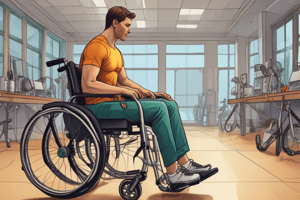Podcast
Questions and Answers
Which muscle is innervated by the C7 myotome?
Which muscle is innervated by the C7 myotome?
- Long finger flexors
- Elbow extensors (correct)
- Wrist extensors
- Deltoid
Which myotome is responsible for ankle plantar flexion?
Which myotome is responsible for ankle plantar flexion?
- L5
- L4
- L3
- S1 (correct)
What is the classification for a spinal cord injury that results in significant impactful trauma?
What is the classification for a spinal cord injury that results in significant impactful trauma?
- Posterior Cord Syndrome
- Anterior Cord Syndrome
- Central Cord Syndrome
- Complete SCI (correct)
Which classification of spinal cord injury is associated with loss of pain and temperature sensation, but preserved light touch and proprioception?
Which classification of spinal cord injury is associated with loss of pain and temperature sensation, but preserved light touch and proprioception?
Which age group is most commonly affected by traumatic spinal cord injury?
Which age group is most commonly affected by traumatic spinal cord injury?
Which region of the spinal cord has spinal nerves found above the corresponding vertebrae, except the C8 spinal nerve?
Which region of the spinal cord has spinal nerves found above the corresponding vertebrae, except the C8 spinal nerve?
What does myotome refer to?
What does myotome refer to?
What is the peripheral nerve field?
What is the peripheral nerve field?
Where are remaining spinal nerves found in relation to the corresponding vertebrae?
Where are remaining spinal nerves found in relation to the corresponding vertebrae?
What does dermatome refer to?
What does dermatome refer to?
Flashcards are hidden until you start studying
Study Notes
Spinal Cord and Nerve Basics
- The muscle innervated by the C7 myotome is not specified.
Spinal Cord Injury Classification
- A spinal cord injury resulting in significant impactful trauma is classified as a Complete Spinal Cord Injury.
Dermatome and Myotome
- A myotome refers to a group of muscles innervated by a single spinal nerve or nerve root.
- A dermatome refers to an area of skin innervated by a single spinal nerve.
- The peripheral nerve field refers to the area of the body supplied by a specific nerve.
Spinal Nerve and Vertebrae Relations
- Spinal nerves found above the corresponding vertebrae, except for the C8 spinal nerve, are located in the cervical region.
- Remaining spinal nerves are found below the corresponding vertebrae.
Spinal Cord Injury Epidemiology
- The age group most commonly affected by traumatic spinal cord injury is young adults.
Studying That Suits You
Use AI to generate personalized quizzes and flashcards to suit your learning preferences.




